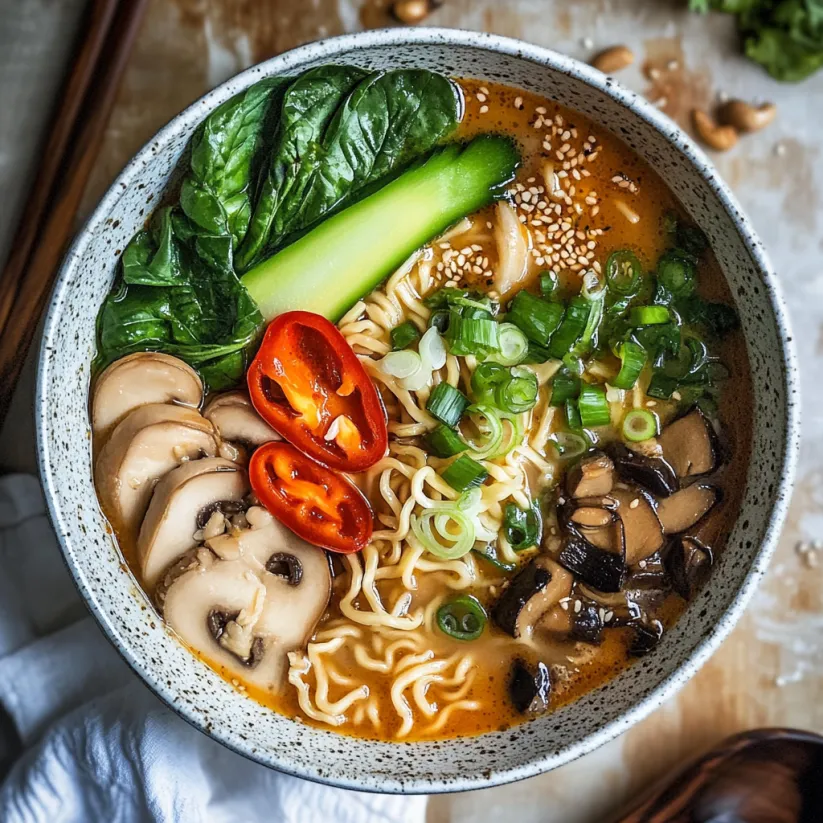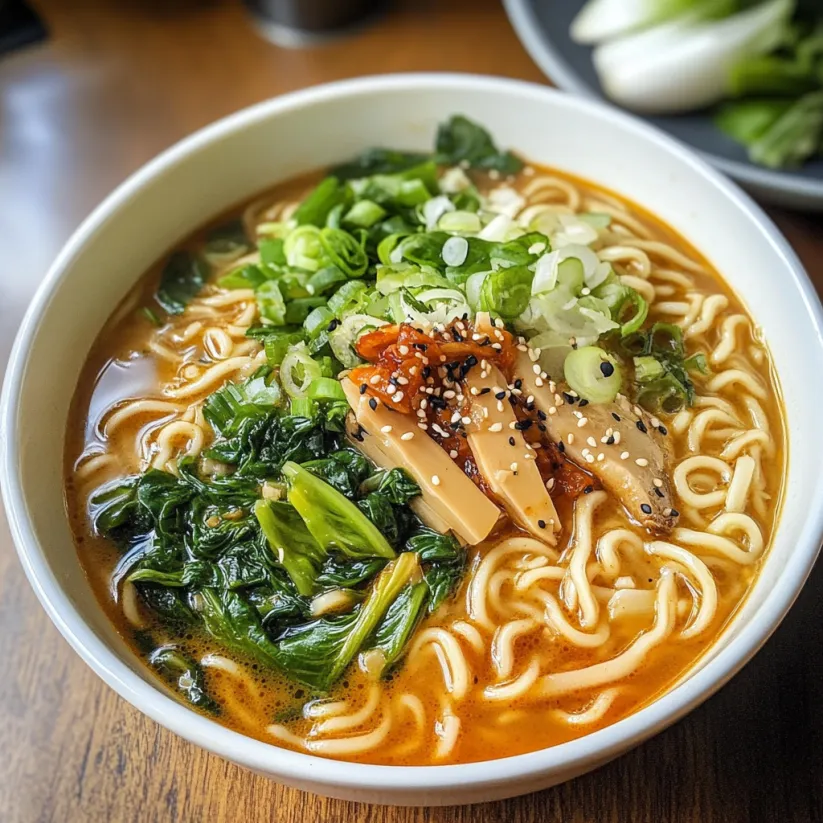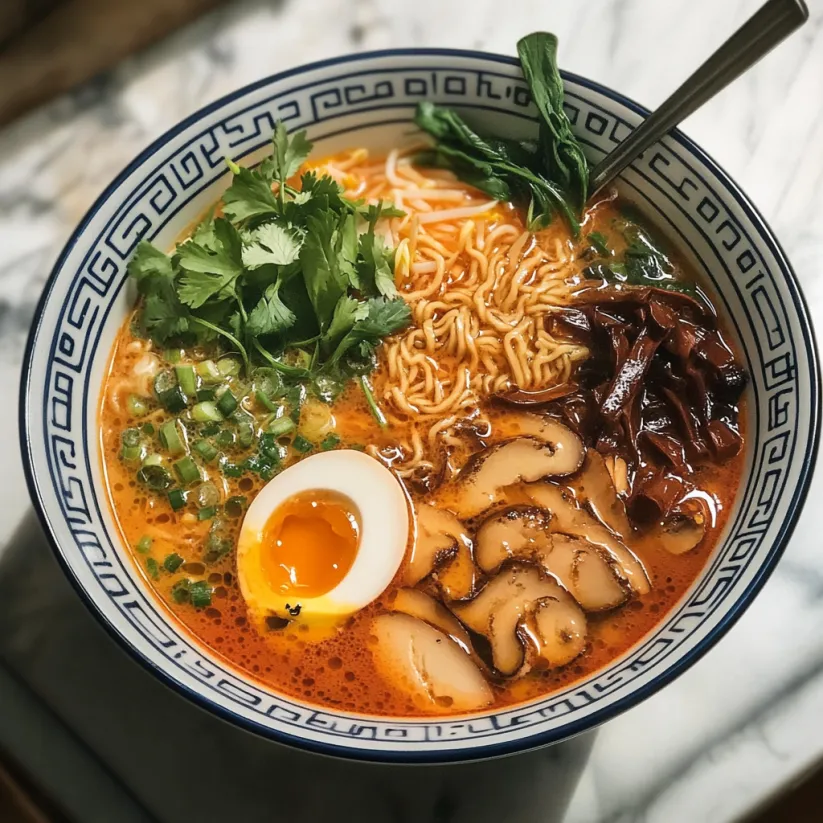 Save Pin
Save Pin
This hearty vegan spicy miso ramen has become my go-to comfort meal on cold evenings. The rich, umami-packed broth comes together in one pot, making it perfect for busy weeknights when you crave something warming and satisfying.
I first discovered the magic of homemade miso ramen during a particularly stressful work week. The combination of spicy broth and chewy noodles was so comforting that it's now my reliable mood booster whenever life gets hectic.
Ingredients
- Sesame oil creates the aromatic foundation for the entire dish and adds a nutty depth you simply can't skip
- Ginger and garlic provide essential aromatics that wake up your taste buds and add complexity
- Scallions deliver freshness and mild onion flavor, separating white and green parts maximizes their potential
- White miso paste contributes the signature umami flavor and silky texture to the broth
- Peanut butter or Asian sesame paste adds creaminess and body to the broth without dairy
- Doubanjiang or chili paste brings customizable heat and complexity
- Vegetable broth forms the liquid base, use high quality for best flavor
- Soy milk creates silkiness without dairy, oat milk works beautifully too
- Japanese chili oil adds gorgeous red color and aromatic spice
- Dried shiitake mushrooms infuse the broth with incredible umami depth
- Soy sauce balances all flavors with its savory saltiness
- Bok choy provides fresh green balance to the rich broth
- Instant ramen noodles offer that perfect chewy texture we all crave
- Corn kernels add sweet pops of texture and color
Step-by-Step Instructions
- Build Your Flavor Base
- Heat sesame oil in a medium pot over medium high heat until shimmering. Add minced garlic, grated ginger, and white parts of scallions. Sauté for 1 to 2 minutes until intensely fragrant but not browned. The oil will capture these essential flavors and distribute them throughout your broth.
- Create The Paste Mixture
- Lower heat to medium and add miso paste, peanut butter or sesame paste, and doubanjiang. Stir continuously until they form a uniform paste. This step is crucial as it ensures these powerful ingredients blend properly without burning or clumping. The paste will look thick and slightly oily.
- Develop The Broth
- While stirring continuously, gradually pour in the vegetable broth and soy milk. Keep stirring until all paste is completely dissolved. Add chili oil and dried shiitake mushrooms. Cover the pot and bring to a boil over medium high heat for about 5 minutes. This gentle simmer extracts flavor from the mushrooms while allowing all ingredients to meld.
- Finish The Broth
- Taste your broth and adjust seasoning with soy sauce and salt if needed. Remove the rehydrated mushrooms and slice them into thin strips. The broth should now be rich, aromatic, and have a beautiful reddish hue from the chili oil.
- Cook Vegetables And Noodles
- Add halved bok choy to the simmering broth and cook until just tender, about 2 minutes. Add the instant ramen brick directly to the pot. You can turn off the heat now if your noodles cook quickly, or leave on low heat until noodles reach your preferred chewiness, usually 2 to 3 minutes.
- Garnish And Serve
- Add corn kernels, green scallion parts, and sesame seeds. Top with additional chili oil if desired and serve with roasted nori sheets. Enjoy immediately while hot for the best texture and flavor experience.
 Save Pin
Save Pin
I obsess over the combination of miso and peanut butter in this recipe. The first time I tasted this pairing, it was truly a revelation. The miso brings that savory depth while the peanut butter adds creaminess that makes the broth incredibly satisfying without a drop of dairy.
Perfect Noodle Texture
The secret to perfect ramen noodles is cooking them just slightly less than you think they need. They will continue absorbing liquid in the hot broth even after you turn off the heat. I prefer removing them when they still have a substantial bite, ensuring they won't become mushy by the time you finish the bowl. For leftovers, always store noodles separately from broth to maintain their texture.
Make It Your Own
This recipe welcomes endless variations based on what you have available. No bok choy? Try spinach, kale, or even broccoli florets. The peanut butter can be replaced with tahini or almond butter for different flavor profiles. For protein additions, consider adding cubed tofu, tempeh, or even some vegan chicken alternatives. The dried shiitake mushrooms can be supplemented or replaced with fresh mushrooms like cremini or enoki for varied textures and flavors.
The Art Of Miso
Miso paste is the soul of this recipe, and understanding its varieties can elevate your ramen experience. White miso offers a mild, slightly sweet flavor perfect for this balanced broth. Yellow miso will give a slightly stronger taste, while red miso provides the most robust flavor that can sometimes dominate other ingredients. Store your miso paste in the refrigerator with the top sealed tightly it will keep for months and improve countless soups, dressings, and marinades beyond this ramen recipe.
 Save Pin
Save Pin
Commonly Asked Questions
- → Can I make this spicy miso ramen less spicy?
Absolutely! You can easily adjust the spice level by reducing or omitting the doubanjiang (chili paste) and layu (chili oil). Start with just 1/2 tablespoon of doubanjiang instead of a full tablespoon, and add chili oil only at the end to taste. The miso and other ingredients will still provide plenty of flavor without the heat.
- → What can I substitute for bok choy?
Many greens work beautifully in this ramen. Try spinach, kale, tatsoi, napa cabbage, or even regular cabbage. For heartier greens like kale, you may want to add them earlier in the cooking process to ensure they soften properly. Spinach can be added right at the end as it wilts quickly.
- → Can I use other types of plant-based milk?
Yes! While soy milk provides a nice creamy texture with neutral flavor, other plant-based milks work well too. Oat milk makes an excellent substitute with its natural sweetness and creaminess. Almond milk is another option, though it's slightly thinner. Coconut milk will add a distinct flavor that changes the profile of the dish but can be delicious in its own way.
- → How can I make this ramen more filling?
To make this ramen more substantial, consider adding protein-rich toppings such as pan-fried tofu cubes, tempeh, or seitan. You can also increase the vegetables by adding thinly sliced carrots, bean sprouts, or enoki mushrooms. For added texture and nutrition, sprinkle with roasted peanuts or cashews before serving.
- → Can I prepare any components ahead of time?
Yes! You can prepare the broth base up to 3 days in advance and store it in the refrigerator. Simply reheat the broth, then add the noodles and fresh vegetables when you're ready to serve. This makes weeknight dinners much quicker. You can also pre-chop all the vegetables and store them in airtight containers in the refrigerator for 1-2 days before using.
- → What type of miso paste works best?
White miso (shiro miso) is recommended for this recipe as it has a milder, sweeter flavor that works well with the other ingredients. However, you can experiment with different types for varied results. Yellow miso (shinsu miso) will give a slightly stronger flavor, while red miso (aka miso) will provide a more robust, intense taste that can stand up to the spice elements.
